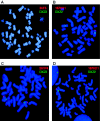A novel class of Pseudoautosomal region 1 deletions downstream of SHOX is associated with Leri-Weill dyschondrosteosis
- PMID: 16175500
- PMCID: PMC1275603
- DOI: 10.1086/449313
A novel class of Pseudoautosomal region 1 deletions downstream of SHOX is associated with Leri-Weill dyschondrosteosis
Erratum in
- Am J Hum Genet. 2005 Dec;77(6):1131. Huber, Celine [corrected to Huber, Céline]; Del Blanco, Darya Gorbenko [corrected to Gorbenko del Blanco, Darya]; Rappold, Gudrun [added]; Argente, Jesus [corrected to Argente, Jesús]; Cormier-Daire, Valerie [corrected to Cormier-Daire, Valrie]
Abstract
Leri-Weill dyschondrosteosis (LWD) is a pseudoautosomal dominant disorder characterized by disproportionate short stature and a characteristic curving of the radius, known as the "Madelung deformity." SHOX mutations resulting in SHOX haploinsufficiency have been found in LWD and in a variable proportion of patients with idiopathic short stature (ISS), whereas homozygous loss of SHOX results in the more severe Langer mesomelic dysplasia (LMD). Defects in SHOX have been identified in approximately 60% of LWD cases, whereas, in the remaining approximately 40%, the molecular basis is unknown. This suggests either genetic heterogeneity or the presence of mutations in unanalyzed regions of SHOX, such as the upstream, intragenic, or downstream regulatory sequences. Therefore, the pseudoautosomal region 1 (PAR1) of 80 patients with LWD, in whom SHOX deletions and mutations had been excluded, was screened for deletions by use of a new panel of microsatellite markers. We identified 12 patients with LWD who presented with a novel class of PAR1 deletions that did not include SHOX. The deletions were of variable size and mapped at least approximately 30-530 kb downstream of SHOX. In our cohort, this type of deletion accounted for 15% of cases. In all cases, the deletions cosegregated with the phenotype. No apparent phenotypic differences were observed between patients with SHOX deletions and those with this new class of PAR1 deletions. Thus, we present here the identification of a second PAR1 region implicated in the etiopathogenesis of LWD. Our findings suggest the presence of distal regulatory elements of SHOX transcription in PAR1 or, alternatively, the existence of an additional locus apparently involved in the control of skeletal development. Deletion analysis of this newly identified region should be included in the mutation screening of patients with LWD, LMD, and ISS.
Figures




Comment in
-
Transactivation function of an approximately 800-bp evolutionarily conserved sequence at the SHOX 3' region: implication for the downstream enhancer.Am J Hum Genet. 2006 Jan;78(1):167-70. doi: 10.1086/499254. Am J Hum Genet. 2006. PMID: 16385461 Free PMC article. No abstract available.
References
Web Resources
-
- dbSNP, http://www.ncbi.nlm.nih.gov/SNP/ (for SNPs, including the newly identified rs38346958, rs38346959,rs38346960, rs38346961, rs38346962, rs38346963,rs38346964, rs38346965, rs38346966, and rs38346967)
-
- Ensembl Genome Browser, http://www.ensembl.org/Homo_sapiens/ (for sequence information of the human X and Y chromosomes)
-
- MRC-Holland B.V., http://www.mrc-holland.com/ (for details of the SHOX MLPA kit)
-
- GDB Human Genome Database, http://www.gdb.org/ (for locus information, including details of the new microsatellites DXYS10080, DXYS10081, DXYS10082, DXYS10083, DXYS10084, DXYS10085, DXYS10086, DXYS10087, DXYS10088, DXYS10089, DXYS10090, DXYS10091, DXYS10092, DXYS10093, DXYS10094, DXYS10095, DXYS10096, and DXYS10097)
-
- NCBI, http://www.ncbi.nlm.nih.gov/entrez/ (for sequence information on the human X and Y chromosomes, including contig NT_028413)
References
-
- Belin V, Cusin V, Viot G, Girlich D, Toutain A, Moncla A, Vekmans M, Merrer ML, Munnich A, Cormier-Daire V (1998) SHOX mutations in dyschondrosteosis (Léri-Weill syndrome). Nat Genet 19:67–69 - PubMed
Publication types
MeSH terms
Substances
LinkOut - more resources
Full Text Sources
Other Literature Sources
Medical

